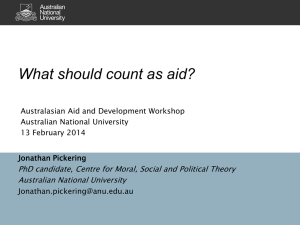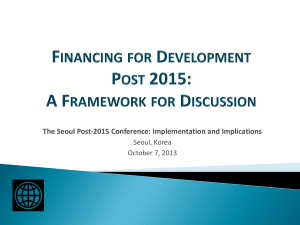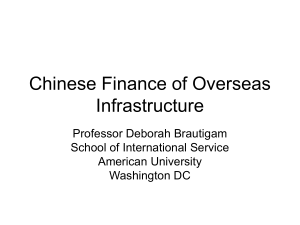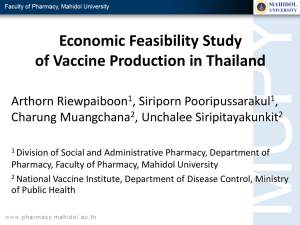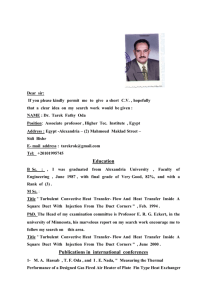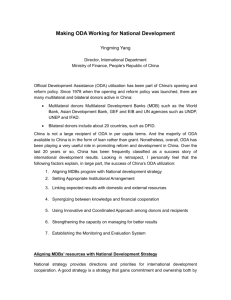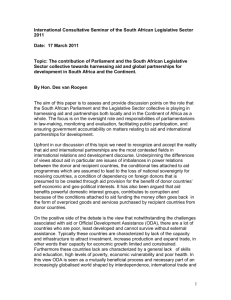Innovative Solutions for Funding Health
advertisement
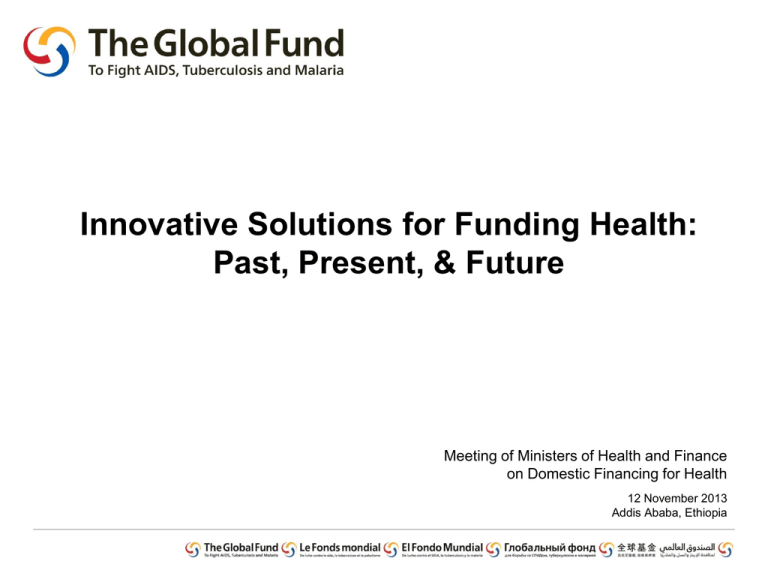
Innovative Solutions for Funding Health: Past, Present, & Future Meeting of Ministers of Health and Finance on Domestic Financing for Health 12 November 2013 Addis Ababa, Ethiopia What we heard from the Honorable Ministers, MPs, Delegates, and Civil Society in the video was encouraging… “Departure from traditional thinking…” “Efficiency & effectively using existing resources…” “Partnership with private sector…” “Community…” “Thinking outside of the box…” “Go beyond the norm…” “Sustainability” “Homegrown…” “Suite the needs of African continent…” Value for Money New technologies “Political will…” In 1962, child mortality and family size divided the world into developed and emerging economies, with little in the gap… Emerging Economies Developed Economies …but over the past 50 years there has been a dramatic shift in the organization of the world trending to smaller families …and then family size declines First, child mortality declines… 2 1 We also start to see longer life expectancy across all countries… Over the past 50 years, life expectancy in the US gained just 7 years as new diseases become more prevalent in society Polio, Measles (1962/63) Influenza Epidemic (1918) Smallpox (1915) Penicillin (1925) As countries experience economic growth, there is a tendency for higher health costs to accumulate later in life… “…nearly 30% of lifetime health expenditure is incurred during middle age… …and nearly an additional 40% during the senior years…” Total: 70-75% In the past decade, Non-ODA has contributed greatly to the development aid universe creating new funding opportunities 600 Type Total Development Aid from 1967 - 2011 10-yr CAGR Non-ODA 37% ODA 9% 500 499 (US$, billions) 400 Type 300 10-yr CAGR Non-ODA -1% ODA -7% 200 Non-ODA + ODA (9%) 100 ODA (7%) 134 1967 1968 1969 1970 1971 1972 1973 1974 1975 1976 1977 1978 1979 1980 1981 1982 1983 1984 1985 1986 1987 1988 1989 1990 1991 1992 1993 1994 1995 1996 1997 1998 1999 2000 2001 2002 2003 2004 2005 2006 2007 2008 2009 2010 2011 0 Source: OECD data 2013; Non-ODA is all aid related investments including PPP, other than Official Development Assistance as defined by OECD. We might want to start thinking a little more creatively and collaboratively about funding health… As the world develops, demographics shift, people live longer… As health interventions become more expensive, and aid more dynamic PRODUCT(RED) Established: 2006 Objectives: To build a commercial development product using consumer contributions Source of funding: Percentage of profit generated from purchase of (RED) products (Apple, Microsoft, Starbucks etc) by consumers worldwide Pays a fee for PRODUCT (RED) (RED) trademark $10 $10 Funding raised to date: > $ 215 Million Impact: 14 million people with HIV/AIDS in Sub-Saharan Africa Advanced Market Commitments (AMC) Established: 2007 Objectives: To stimulate manufacturer to produce new vaccines at affordable prices Source of funding: Donor Governments of Canada, Italy, Norway, Russia, UK and Gates Foundation Assess if the vaccine meet criteria Vaccine Manufacturers Vaccines are delivered to countries Enter into procurement agreement Donor Governments Independent Assessment Committee Provide financial support to AMC Funds UNICEF Contribute to long term cost of the vaccines GAVI Alliance Funding raised to date: US$1.5 billion donor commitment Impact: Access to pneumococcal vaccine 10 years sooner. Could save 1.5 mm lives by 2020. Beneficiaries include Benin, Cameroon, CAR, Congo & other African countries Debt2Health Established: 2007 Objectives: To convert debt service payments into new investments in health Source of funding: Amount of debt foregone in developing country by creditor country Creditor Beneficiary Debt cancellation Counterpart Payment(s) Global Fund Funding of grants based on Performance based funding system Funding raised to date: € 170 million Impact: Debtor countries include Pakistan, Indonesia, Cote d’Ivoire, Egypt The Global Fund’s Focus in Innovative Finance RDI Ratio ODA as a % of Total Development Aid Global Fund’s positioning in Innovative Finance Timeline 15 RDI Ratio: Relationship between a country’s lower disease burden & income level Pay-for-Performance Instrument Product design phase at the Global Fund Objectives: To leverage upfront private investment for malaria intervention programs Source of funding: Impact investors (e.g. high net worth individuals, foundations) 5. Repayment and ROI from performance-based payments Outcome Funders 1. Upfront investment Impact Investors Instrument-issuing organization 2. Funding for operating costs Service Provider 3. Deliver interventions Funding targeted: US$ 20-30 million Impact: Increase efficiency of program implementation Verification Agent 4. Outcome and impact results are independently verified Health Microinsurance Product design phase at the Global Fund Objectives: To build a business model for quality primary health care that is affordable, sustainable, scalable and replicable Source of funding: Donors, private sector companies, government etc Problem Programs Low Productivity Charity/NGO IFI/DFI Solution High Fees Sick Workers Sponsor Family Members Falling Sick HIV/TB Malaria Gov’t Private Sector Solution requires high quality delivered at a very low cost and will need to conquer the barrier of cash payments that keep so many from seeking medical care. Funding Targeted: In discussion with MI intermediaries, telecos, private sector companies Impact: Overall goal is universal health coverage. Pilot will be initiated in a few countries Numerous Innovative Financing mechanisms exist… Taxes Voluntary Solidarity Contribution Debt Instruments Air ticket tax PRODUCT (RED) Sustainable Investing Bonds Global Solidarity Tobacco Contribution MassiveGood Pay-forPerformance National Lotteries Financial Transaction Tax Remittance tax Crowdsourcing Matching fund Diaspora Bonds PublicPrivate Incentives Advance Market Commitments Affordable Medicines Facility for Malaria (AMFm) Vaccine Bonds (IFFIm ) Debt2Health Health Micro Insurance Contact Information Innovative Finance Department Makiko Takayama Specialist makiko.takayama@theglobalfund.org Adam Bornstein Specialist adam.bornstein@theglobalfund.org



